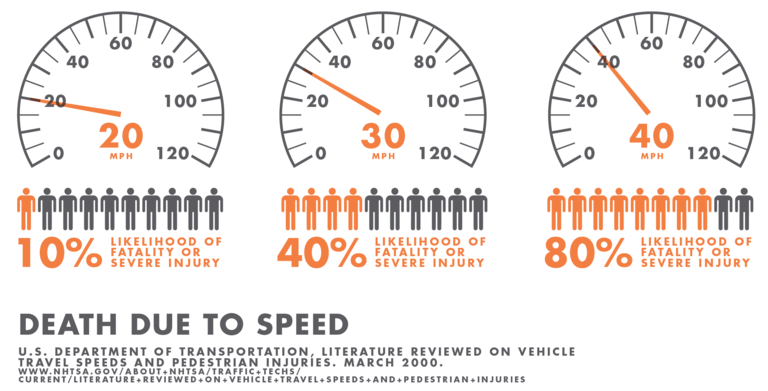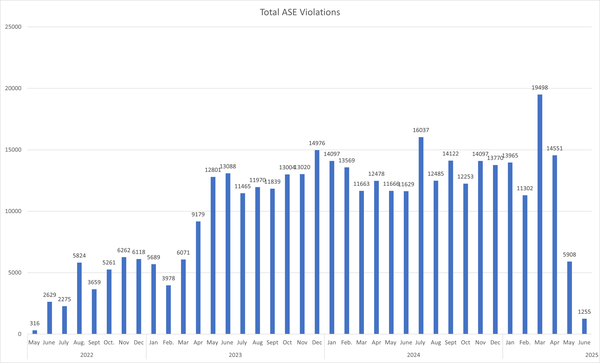Automated Speed Enforcement (ASE)
Information about the City of Albuquerque's Automated Speed Enforcement program.
Everyone deserves to be safe while traveling our roadways in Albuquerque. Driving the speed limit is one way to help people get from point a to point b safely. Speed increases both the likelihood of a crash and the severity of the crash.

Automated speed enforcement is an effective tool to make roads safer and enforce posted speed limits. Automated speed enforcement programs have been shown to reduce vehicle speeds, crashes, injuries and fatalities. Automated enforcement does not require traffic stops, and can improve safety for all road users in a neutral manner.
Vehicles speeding through automated enforcement areas may receive a $100 ticket citation. Sample citation.
Read the Automated Speed Enforcement Ordinance O-23-78. Read the Automated Speed Enforcement regulation.
Frequently Asked Questions
Answers to frequently asked questions about Automated Speed Enforcement are located on the following topic based pages.
Resolving an Automated Speed Enforcement Citation
If your citation begins with "ABQ--"
You may view your violation images and video and pay your fine at https://usview.cite-web.com by entering your plate number and password from your citation. More payment information is available at the FAQ page, or by calling the Albuquerque Automated Enforcement Division Customer Service Call Center toll free at 844-652-0888. To resolve your citation through community service, you must first select the community service option on ZeroFatality.com. For support completing your community service, please refer to our Community Service Guide.
If your citation begins with "1024--"
You may view your violation images and video and pay your fine at ZeroFatality.com by entering your plate number and password from your citation. More payment information is available at the FAQ page, or by calling the Albuquerque Automated Enforcement Division Customer Service Call Center toll free at 866-247-8157. To resolve your citation through community service, you must first select the community service option on ZeroFatality.com.
Scam Alert: The City of Albuquerque and the Albuquerque Police Department will never contact an individual requesting money or payments for automated speed enforcement over the phone. Please disregard these calls and messages. If you believe you have been contacted by someone who is impersonating an officer, please call 242-COPS to report.
Automated Speed Enforcement Forms
- Owner’s Affidavit for citations beginning with "102400000--"
- Owner's Affidavit for citations beginning with "ABQ--"
- Payment Plan Request Form
- Request a copy of my citation
Automated Speed Enforcement Statistics

The bar graph shows the monthly Automated Speed Enforcement warnings and citations issued from April 25, 2022 (when the program started) to present. As the City added more speed safety cameras throughout 2022 and 2023, citations increased each month. The City currently has 20 speed safety cameras and at this time is not adding additional cameras. Starting September 6, 2022, the City stopped issuing warnings and began only issuing citations. The City issued 10,749 warnings. Staff update the bar graph approximately every quarter. Between April 25, 2022 and June 30, 2025, the City issued 378,549 citations through our initial vendor. Data from April to June 2025 will be updated with citation data from the new vendor when it becomes available.
A total of 17,168 Community Service hours have been completed to resolve ASE citations since this program started.
Automated Speed Enforcement System Information
NovoaGlobal System Information
Elovate System Information
- System Test Certificates
- Ellison @ Black Diversion Channel Trail (EB)
- Unser @ Flor Del Sol (NB)
- Central between New York and Tingley (WB)
- Lomas @ 3rd (EB)
- Unser @ Tower (NB)
- Montgomery @ Jennifer (WB)
- 98th between Tower and Central (NB)
- Montgomery @ Julie (EB)
- Broadway north of Iron (SB)
- Lomas @ Virginia (WB)
- San Mateo north of Montgomery (SB)
- Coal @ Cornell (EB)
- Wyoming @ Academy (NB)
- Coors Bypass just south of Ellison (SB)
- Coors between Montano and Paseo del Norte (NB)
- Paseo @ Louisiana (WB)
- Eubank @ Buena Ventura (NB)
- Gibson between Carlisle and San Mateo (EB)
- Gibson between Carlisle and San Mateo (WB)
- View calibration certificates
- Ellison @ Black Diversion Channel Trail (EB)
- Unser @ Flor Del Sol (NB)
- Central between New York and Tingley (WB)
- Lomas @ 3rd (EB)
- Unser @ Tower (NB)
- Montgomery @ Jennifer (WB)
- 98th between Tower and Central (NB)
- Montgomery @ Julie (EB)
- Broadway just north of Iron (SB)
- Lomas @ Virginia (WB)
- San Mateo just north of Montgomery (SB)
- Coal @ Cornell (EB)
- Wyoming @ Academy (NB)
- Coors Bypass just south of Ellison (SB)
- Coors between Montano and Paseo del Norte (NB)
- Paseo @ Louisiana (WB)
- Eubank @ Buena Ventura (NB)
- Gibson between Carlisle and San Mateo (EB)
- Gibson between Carlisle and San Mateo (WB)
For Additional Assistance:
Call: 311
Email: [email protected]